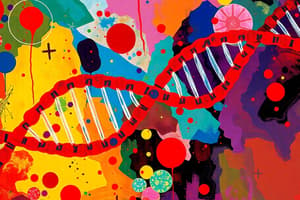Podcast
Questions and Answers
What differentiates amateur practice from professional practice?
What differentiates amateur practice from professional practice?
- Amateurs stop when they succeed, while professionals practice until they cannot fail. (correct)
- Amateurs seek immediate results, while professionals aim for long-term mastery.
- Amateurs practice frequently, while professionals practice occasionally.
- Amateurs focus on perfection, while professionals focus on consistency.
Which part is NOT typically found in a prokaryotic gene?
Which part is NOT typically found in a prokaryotic gene?
- RNA coding region
- Transcription terminator
- Exon-intron structure (correct)
- Promoter
What is a function of the promoter in a prokaryotic gene?
What is a function of the promoter in a prokaryotic gene?
- To specify the amino acid sequence of proteins.
- To signal the termination of transcription.
- To initiate the binding of transcription factors. (correct)
- To provide a template for mRNA synthesis.
Which consensus sequence is part of E. coli promoters?
Which consensus sequence is part of E. coli promoters?
What is the function of the transcription terminator in a prokaryotic gene?
What is the function of the transcription terminator in a prokaryotic gene?
Which of the following elements is NOT included in bacterial promoters?
Which of the following elements is NOT included in bacterial promoters?
What is the first step of transcription initiation in E. coli?
What is the first step of transcription initiation in E. coli?
Which element serves as a core-recognition element in bacterial promoters?
Which element serves as a core-recognition element in bacterial promoters?
What are the components found in the structure of a prokaryotic gene?
What are the components found in the structure of a prokaryotic gene?
Which region is responsible for initiating transcription in prokaryotic DNA?
Which region is responsible for initiating transcription in prokaryotic DNA?
What is the function of sigma domain 2 during transcription?
What is the function of sigma domain 2 during transcription?
In the structure of prokaryotic mRNA, what do the terms ORF 1 and ORF 2 refer to?
In the structure of prokaryotic mRNA, what do the terms ORF 1 and ORF 2 refer to?
What occurs at position +1 during transcription in prokaryotes?
What occurs at position +1 during transcription in prokaryotes?
Which component interacts with the -35 element of the prokaryotic promoter?
Which component interacts with the -35 element of the prokaryotic promoter?
In prokaryotic mRNA, what does the 5' UTR primarily function as?
In prokaryotic mRNA, what does the 5' UTR primarily function as?
What structural feature is NOT present in prokaryotic genes?
What structural feature is NOT present in prokaryotic genes?
What is the role of the sigma factor in transcription?
What is the role of the sigma factor in transcription?
Which sigma domain is responsible for interacting with the -35 element?
Which sigma domain is responsible for interacting with the -35 element?
What triggers the dissociation of the sigma factor during transcription?
What triggers the dissociation of the sigma factor during transcription?
What is the structure of the intrinsic terminator sequence in transcription termination?
What is the structure of the intrinsic terminator sequence in transcription termination?
What occurs during abortive initiation in transcription?
What occurs during abortive initiation in transcription?
How does Rho factor contribute to factor-dependent termination?
How does Rho factor contribute to factor-dependent termination?
What is the function of sigma domain 2 during transcription initiation?
What is the function of sigma domain 2 during transcription initiation?
Which feature is NOT characteristic of intrinsic termination of transcription?
Which feature is NOT characteristic of intrinsic termination of transcription?
Flashcards
Protein-coding gene
Protein-coding gene
A nucleotide sequence that specifies the order of amino acids in a polypeptide.
RNA gene
RNA gene
A nucleotide sequence that specifies the order of RNA nucleotides.
Promoter (gene)
Promoter (gene)
A DNA region that signals where transcription begins and sets the direction.
Transcription Terminator
Transcription Terminator
Signup and view all the flashcards
Pribnow box
Pribnow box
Signup and view all the flashcards
Transcription initiation (E.coli)
Transcription initiation (E.coli)
Signup and view all the flashcards
Transcription elongation
Transcription elongation
Signup and view all the flashcards
Consensus sequence
Consensus sequence
Signup and view all the flashcards
Intrinsic termination
Intrinsic termination
Signup and view all the flashcards
Factor-dependent termination
Factor-dependent termination
Signup and view all the flashcards
Sigma factor
Sigma factor
Signup and view all the flashcards
Sigma Factor Domains (order)
Sigma Factor Domains (order)
Signup and view all the flashcards
Abortive initiation
Abortive initiation
Signup and view all the flashcards
RNA Polymerase
RNA Polymerase
Signup and view all the flashcards
Prokaryotic gene structure
Prokaryotic gene structure
Signup and view all the flashcards
Promoter region
Promoter region
Signup and view all the flashcards
RNA Coding Region
RNA Coding Region
Signup and view all the flashcards
Prokaryotic mRNA structure
Prokaryotic mRNA structure
Signup and view all the flashcards
5' and 3' UTRs
5' and 3' UTRs
Signup and view all the flashcards
ORF (Open Reading Frame)
ORF (Open Reading Frame)
Signup and view all the flashcards
Transcription (bacteria)
Transcription (bacteria)
Signup and view all the flashcards
Sigma factors (-10 and -35 elements)
Sigma factors (-10 and -35 elements)
Signup and view all the flashcards
Study Notes
Prokaryotic Transcription
- Amateur practices until right, professional until cannot get wrong.
- Prokaryotic genes have a promoter, an RNA-coding region, and a transcription terminator.
- Gene structure involves a protein-coding gene with a nucleotide sequence encoding amino acid order in a polypeptide. There is also an RNA gene, whose sequence determines the rNTP order in an RNA molecule.
- In E. coli promoters, consensus sequences are -35 and -10 elements.
- Additional regulatory elements exist in bacterial promoters, such as UP element, EXT, DIS, and CRE. Bacterial promoters don't always contain all of these elements.
- Transcription initiation involves promoter recognition, formation of closed and open complex.
- Transcription elongation is an ongoing process.
- Transcription termination has two types: intrinsic and factor-dependent.
Transcription in E. coli
- Transcription initiation detailed steps: promoter recognition, formation of the closed complex, and formation of the open complex.
- The sigma factor recognizes and binds to promoter consensus sequences.
- Sigma factor domains interact with different parts of the promoter: sigma 4 to -35 element, sigma 3 to EXT, sigma 2 to -10 element, and sigma 1 to RNAP active site.
- Sigma domain 1 blocks template access to RNA polymerase.
- Sigma domain 2 interacts with -10 sequences causing strand melting.
- Sigma domain 3 interacts with EXT, and 4 with -35.
- Abortive initiation involves 2-6 nucleotides.
- After ~12 nucleotides, sigma factor dissociates.
Prokaryotic mRNA
- Prokaryotic mRNA structure includes the Shine-Dalgarno sequence for bacteria (not other prokaryotes), a 5' untranslated region, a protein coding region, and a 3' untranslated region.
- Start and stop codons are a part of prokaryotic mRNA.
RNA Polymerase
- RNA polymerase holoenzyme binds to the promoter.
- The RNA polymerase transcription bubble forms.
Transcription Termination
- Intrinsic termination involves a GC-rich palindrome followed by a poly-A stretch on the template strand. This creates a GC hairpin loop leading to weak U:A hybrid separation.
- Factor-dependent termination involves the rho factor interacting with the rut site on the transcript and moving toward the 3' end. It separates RNA polymerase from the template.
Studying That Suits You
Use AI to generate personalized quizzes and flashcards to suit your learning preferences.




